How I Developed This Recipe
Wasabi-ae (わさび和え) is a versatile Japanese technique where various ingredients are dressed with wasabi-either as the star or supporting flavor-harnessing its distinctive pungency and aroma. In essence, it refers to any dressed salad featuring wasabi.
This particular recipe was a happy accident, born when I was experimenting with leftover enoki mushrooms and bok choy from my refrigerator. I hadn’t initially intended to develop it into a formal recipe.
But the end result was a suprisingly subtle, very Japanese flavor profile that’s worth sharing. If you’ve got enoki mushrooms, bok choy or any other similar vegetables on hand, you should definitely give this simple yet elegant dish a try.

Key Ingredients & Substitution Ideas

- Bok Choy (also known as pak choi): I chose this vegetable for it’s crunchy yet juicy stems paired with tender leaves, the texture is really perfect for this dish and the fresh flavor is an added bonus. If you’re looking for substitutions, spinach or napa cabbage are ideal (although napa cabbage might need slightly longer cooking).
- Enoki mushrooms: These tiny white mushrooms really have a texture like no other, I literally can’t think of anything I could compare them to. They don’t have much flavor, so the sauce can really take center stage. That said, you can swap them for your favorite mushrooms and just thinly slice them.
- Dashi: I used the most common bonito flake and kombu awase dashi, but if you’re making this dish plant-based, you can swap it for kombu dashi or shiitake/kombu awase dashi.
- Condiments: This dish contains your typical Japanese condiments like koikuchi shoyu (dark Japanese soy sauce) and mirin for balanced savoriness and sweetness.
- Umeboshi: Adds a nice tangy flavor to the dish. If you can’t buy real umeboshi, store-bought paste works perfectly well. Homemade umeboshi is often saltier than store-bought versions, so if using, I recommend omitting the salt in the sauce.
Visual Walkthrough & Tips
Here are my step-by-step instructions for how to make this recipe at home. For ingredient quantities and simplified instructions, scroll down for the Printable Recipe Card below.
If you prefer to watch the process in action, check out my YouTube video of this wasabi-ae salad recipe for a complete visual walkthrough!
Start by thinly trimming the bottom of the bok choy stem, then make a crosswise incision. This helps the vegetables cook evenly, reduces blanching time and makes it easier to separate the leaves from the core later.

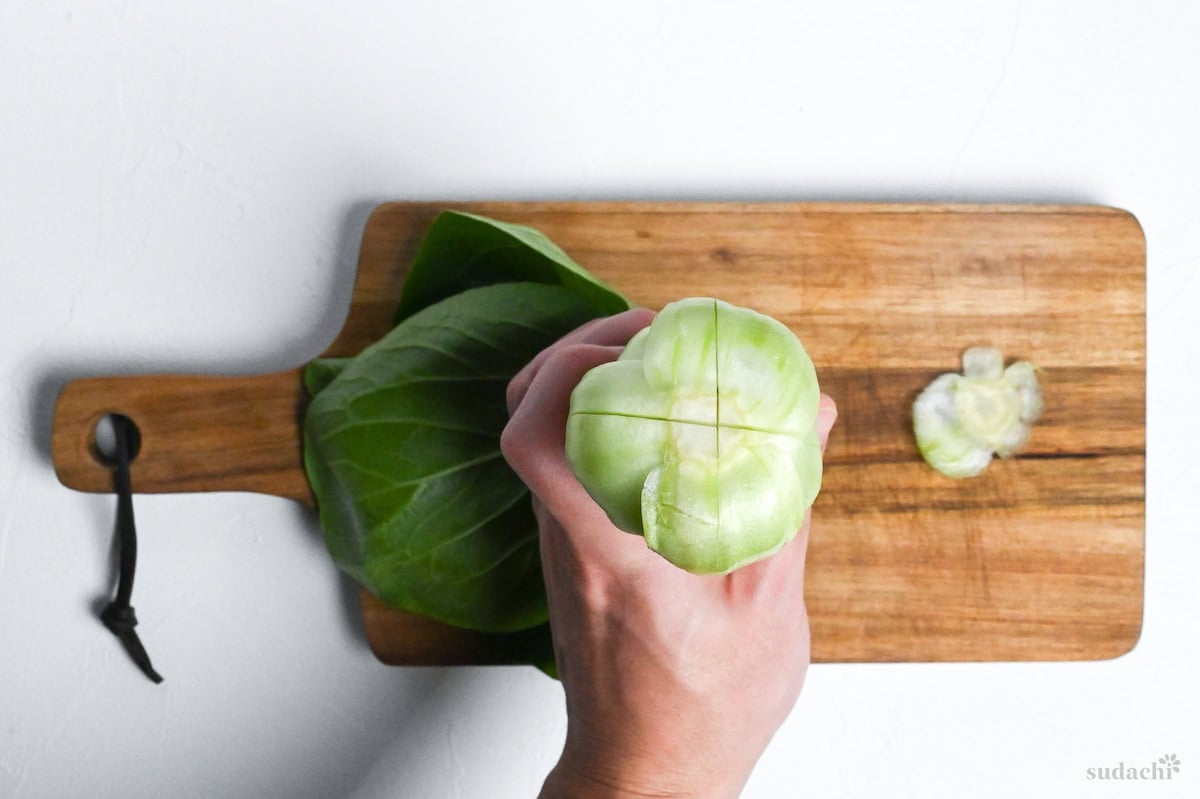
Bring water to just before boiling, and add salt. The ideal temperature is just below the boiling point. This heat can preserve the bok choy’s texture and vibrant color while still softening the fibers.


First, immerse only the thicker stems for 30 seconds, as they’re denser and require a little more cooking time. Then add submerge the rest of the tender leaves and continue blanching for an additional 15 seconds. This two-stage blanching method makes sure the texture is perfect all the way through-crisp stems without overcooked leaves.
Then, put the blanched bok choy in an ice water bath to stop the cooking process. This “shocking” technique keeps the bright green color.

After cooling completely, gently squeeze the bok choy to remove excess water. Excess moisture will dilute the flavorful dressing and potentially make your final dish watery.
While the bok choy cools, gently rinse the enoki mushrooms under cold running water to remove any growing medium residue.
Trim away the tough base of the enoki cluster, then separate the delicate strands.
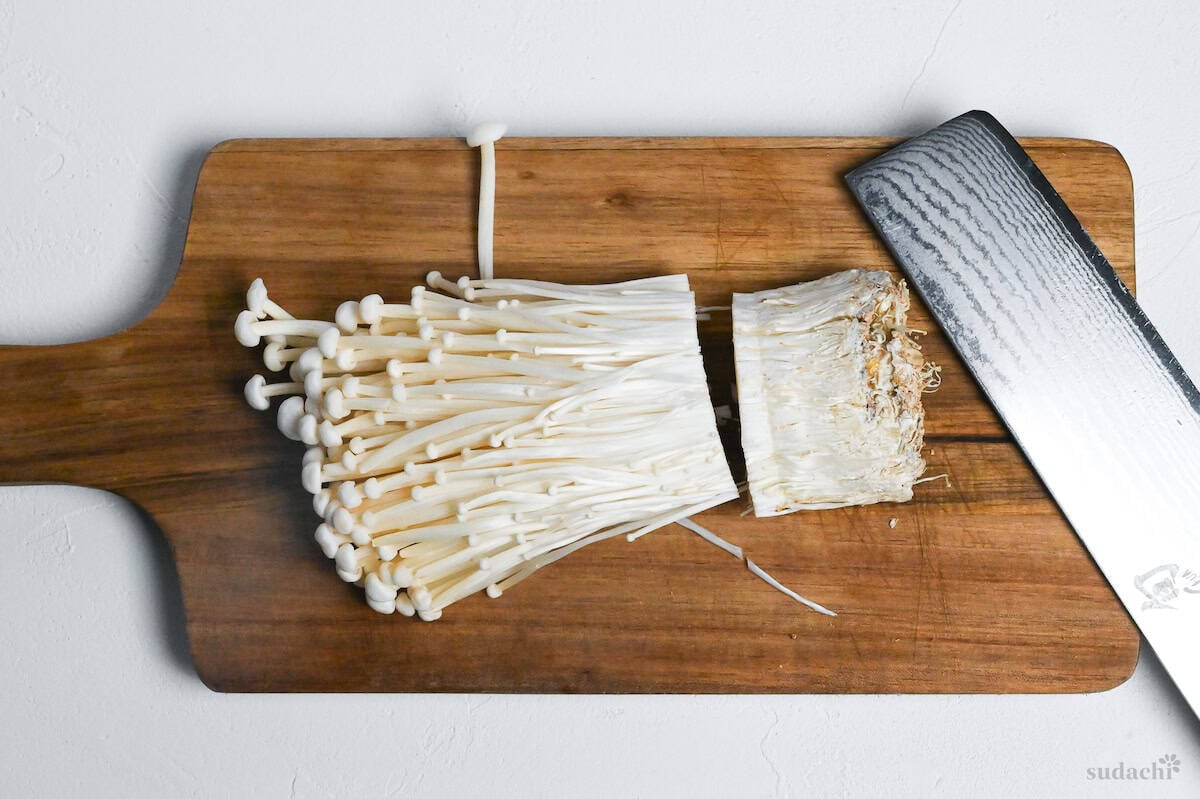
Enoki mushrooms have a natural glutamate content that makes the umami flavor profile of this dish even better. Their delicate texture absorbs the wasabi dressing while maintaining a pleasant bite, creating textural contrast with the bok choy.
For the umeboshi plums, remove the pits and finely chop them until you have a paste-like consistency.

Once the bok choy has cooled enough to handle, squeeze it well and pat dry with paper towels. Excess moisture is the enemy here!

Starting from the base we cut earlier, peel the leaves apart by hand, then cut roughly in half with a knife to separate the tender leaves and thick stems. This will create textural contrast in the final dish.
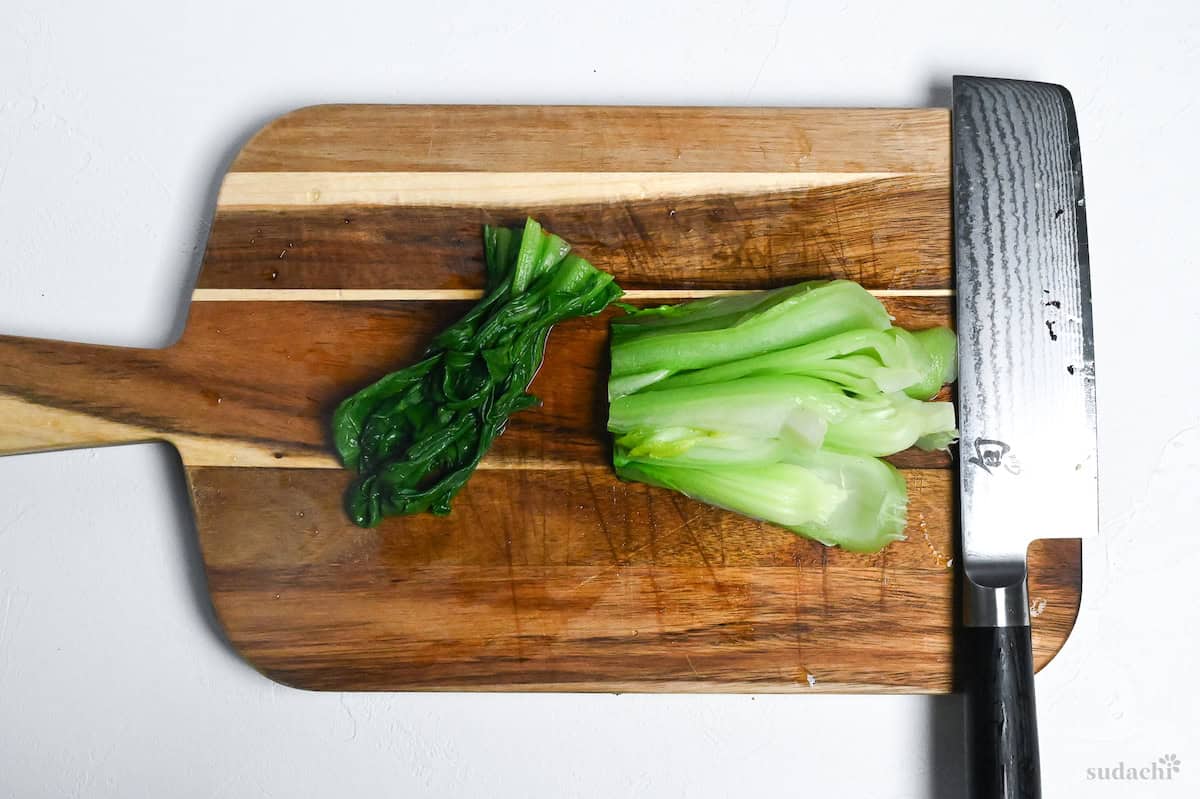
In a saucepan, combine the dashi stock, mirin, salt, soy sauce, and let it boil for about 1 minute. Then, add the enoki mushrooms and gently simmer this mixture over low-medium heat for about 1-2 minutes.
If you’re using especially salty umeboshi (like a homemade version), skip the salt altogether.
Turn off the heat and add the bok choy to the pan. Give it a quick mix and and then remove it from the stove.
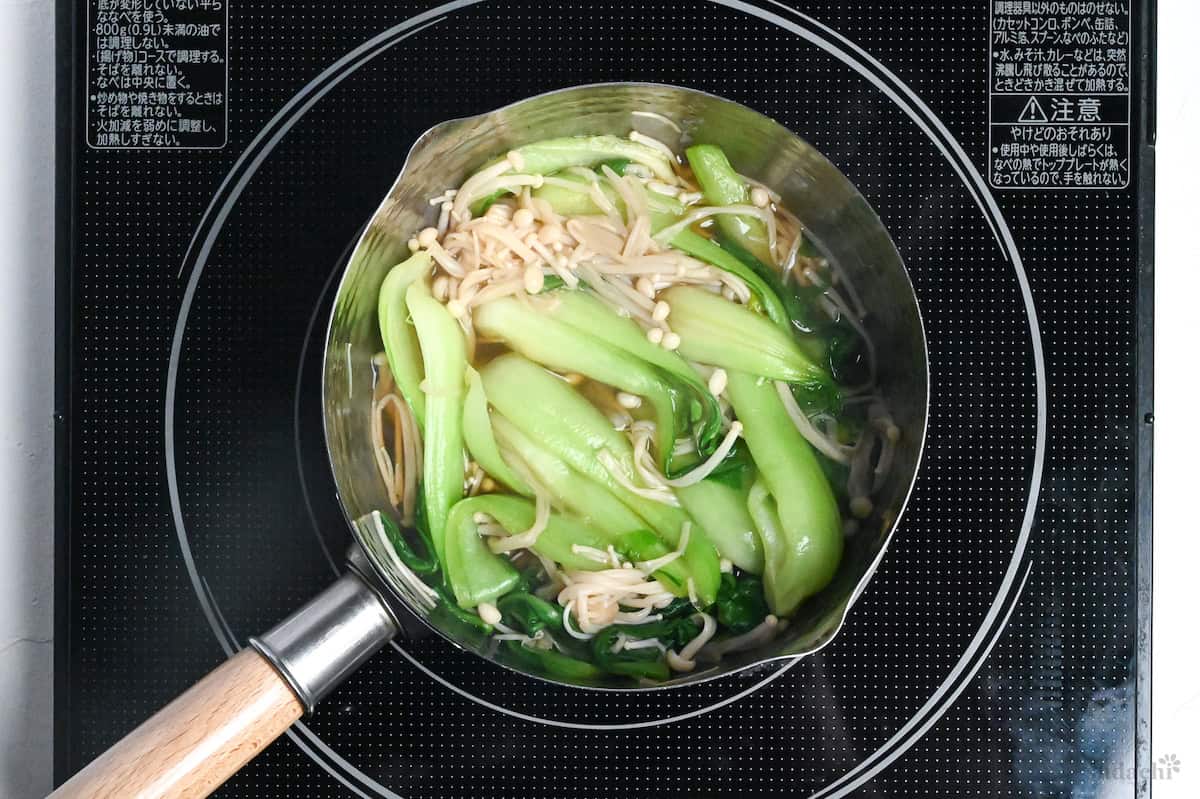
Transfer the warm mixture to a mixing bowl and allow it to cool for 2-3 minutes.

Once slightly cooled, crush the bonito flakes into the bowl-these will partially dissolve, adding another layer of umami complexity.

Now, add the pasted umeboshi and wasabi paste. Store-bought wasabi paste contains volatile compounds that dissipate quickly, especially when heated. Adding it at this last stage preserves its characteristic pungency and aroma.
The umeboshi provides tartness, the dashi contributes savory depth, and the mirin adds subtle sweetness-creating a balanced flavor profile that supports rather than competes with the wasabi.
This versatile wasabi-ae can be enjoyed two ways: serve immediately while still warm for a comforting side dish, or refrigerate for at least 30 minutes for a refreshing cold option. If you go for the cold option, you can add wasabi paste right before serving for a more pronounced flavor.

Upon serving, garnish with a sprinkle of toasted sesame seeds and crushed nori seaweed. Enjoy!
Jump to Full Recipe MeasurementsEssential Tips & Tricks
- Eliminate excess moisture: Gently squeeze blanched vegetables to prevent a watery final dish.
- Add wasabi at the end: Mix in wasabi paste as the final step to preserve its distinctive pungent flavor.
- Don’t overheat the wasabi: Add the wasabi when the mixture is warm or cool (not hot) when adding wasabi to prevent flavor loss.
- Timing matters: Serve immediately warm, or thoroughly chill in the refrigerator.
- Taste before serving: Wasabi flavor varies by brand, so adjust quantity to your preference.
With these simple tips in mind, you’re set for success every time you make this recipe.
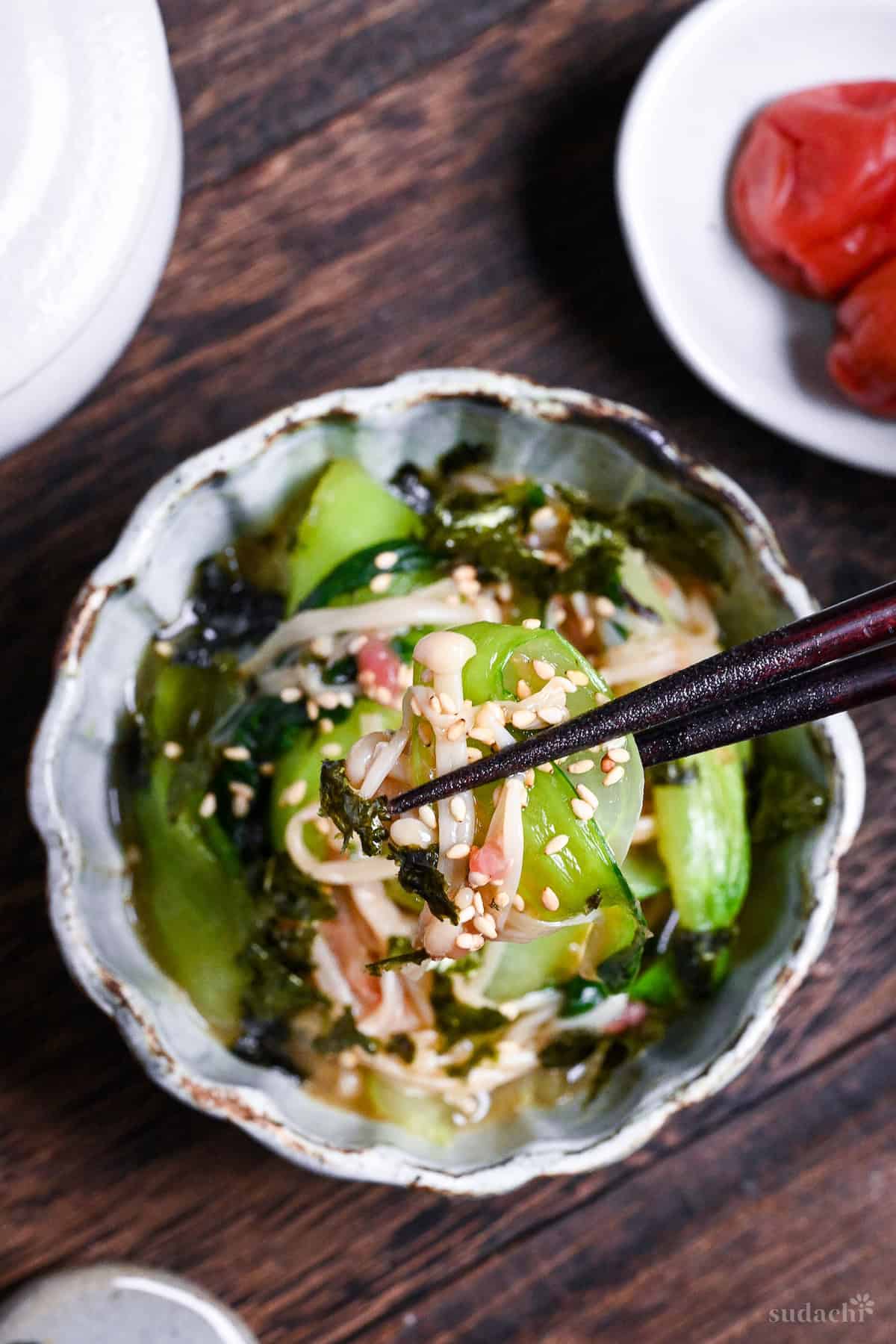
I hope you enjoy this recipe! If you try it out, I’d really appreciate it if you could spare a moment to let me know what you thought by giving a review and star rating in the comments below. It’s also helpful to share any adjustments you made to the recipe with our other readers. Thank you!
More Side Recipes
- Agedashi Tofu (Deep Fried Tofu)
- Hijiki Seaweed Salad (Hijiki no Nimono)
- Simmered Soybeans and Vegetables
- Addictive Potato Salad (Potesara)
Hungry for more? Explore my side recipe collection to find your next favorite dishes!
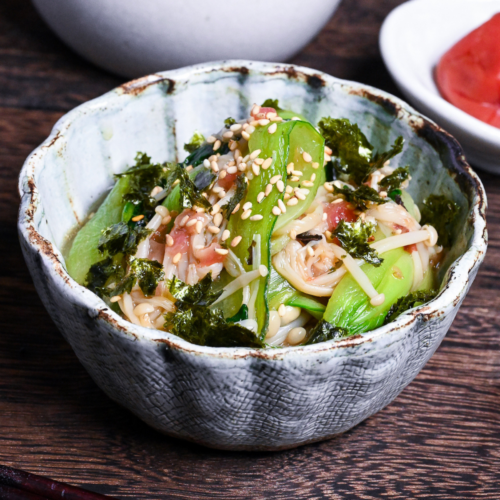
Enoki & Bok Choy Wasabi-Ae
Ingredients
- 1 head bok choy (pak choy)
- 100 g enoki mushrooms
- 4 tbsp dashi stock vegetarians/vegans can used plant-based dashi
- ½ tbsp mirin
- 1 tsp Japanese soy sauce (koikuchi shoyu)
- ¼ tsp salt sea salt preferred
- 2 pickled plums (umeboshi) or store-bought ume paste
- 1 tbsp bonito flakes (katsuobushi) lightly crushed, omit for plant-based diets
- 1 tsp wasabi paste
- 1 tsp toasted sesame oil
- roasted seaweed for sushi (nori) crushed, topping
- toasted white sesame seeds topping
My recommended brands of ingredients and seasonings can be found in my Japanese pantry guide.
Can’t find certain Japanese ingredients? See my substitution guide here.
Instructions
- Start heating a pot of water with a few pinches of salt. Trim the bottom of 1 head bok choy (pak choy) and cut a cross on the bottom about 1cm / ½ inch deep. Prepare a bowl of ice-cold water and place it by the stove.

- Reduce the heat so the water is just below boiling and place the bok choi's stems in the water for 30 seconds. Leave the leaves exposed, leaning over the edge of the pot.

- Submerge the leaves and cook for 15 seconds before transferring the bok choy to an ice-water bath.

- After a few minutes, remove the bok choy from the water and gently squeeze out the water. Place it in a sieve or colander over a bowl and leave to drain any leftover water.

- Wash 100 g enoki mushrooms, cut off the tough base, and separate them.

- Separate the leaves of the bok choy by pulling from the cut at the bottom of the stems.

- Cut them roughly in half to divide the thick stems and tender leaves.

- Pour 4 tbsp dashi stock (liquid, not powder) into a saucepan and add ½ tbsp mirin, 1 tsp Japanese soy sauce (koikuchi shoyu),and ¼ tsp salt. Boil for 1 minutes on medium heat, then reduce to a simmer, add the enoki mushrooms and cook for a further 2 minutes.

- Turn off the heat, add the bok choy to the pan and mix.

- Pour the contents of the pan into a heatproof mixing bowl and leave to cool for 2-3 minutes. Mixing gently will help it cool faster.

- Take 2 pickled plums (umeboshi) and break them open to remove the pits. Use a knife to mash and chop them until they become a paste.

- Add the pasted umeboshi to the bowl along with 1 tbsp bonito flakes (katsuobushi), 1 tsp wasabi paste and 1 tsp toasted sesame oil. Mix well.

- Serve immediately (warm) or cool further and chill in the fridge. Upon serving, sprinkle with crushed roasted seaweed for sushi (nori) and toasted white sesame seeds. Enjoy!

Video
Notes
- Spinach and Napa cabbage are good substitutes for bok choy. Enoki can be replaced with your favorite mushroom thinly sliced.
- Add wasabi paste at the very end of preparation to preserve its volatile compounds and distinctive flavor. You can also add more to taste.
- If you’re using especially salty umeboshi (like homemade pickled plums), skip the salt altogether.
- Store any leftovers for no more than 24 hours, as the wasabi flavor diminishes quickly and vegetables continue to soften.
- Pat vegetables completely dry before dressing to prevent a watery final dish.
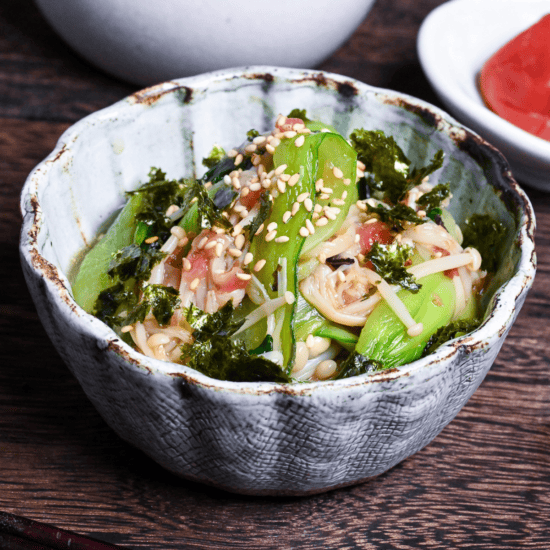







First time to use your AP, pretty cool!
This prep is quite intriguing. Combining umeboshi with wasabi and katsuobushi is something I don’t think I would have ever gotten to on my own. I want to make this exactly how you did and I’m short the plums and mushrooms but I’ll get to it later this week.
Hi John,
Thank you so much for trying the app and for your comment! This combo’s definitely on the experimental side. I’ve been playing around with different Japanese flavors lately, and this one was one of the combos that I liked. Hope you’ll enjoy it once you have all the ingredients!
Yuto